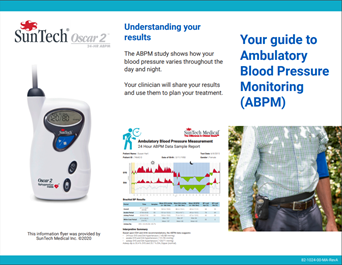![]()
Blog @ SunTech
Advice from the BP Measurement Experts
How to Talk to Your Patients about Ambulatory Blood Pressure Monitoring
The rate of Ambulatory Blood Pressure Monitoring (ABPM) studies is on the rise with more and more clinical organizations recommending ABPM for routine hypertension. While patients are familiar with office and home blood pressure monitors, ABPM remains a relatively unknown procedure. How do you explain ABPM to your patients and ensure you get the compliance you need for accurate diagnosis and treatment?
A patient with high BP readings in the office is a prime candidate for ABPM to confirm diagnosis of hypertension. The American Heart Association recommends either ABPM or home blood pressure monitoring (HBPM) for most patients with high in office BP readings.
| Among adults not taking antihypertensive medication, the ACC/AHA guideline recommends ABPM or HBPM to rule out the presence of white coat hypertension among adults with systolic BP (SBP) between 130 and 159 mm Hg or diastolic BP between 80 and 99 mm Hg, and to identify the presence of masked hypertension among adults with SBP of 120 to 129 mm Hg or DBP of 75 to 79 mm Hg. |
What does a patient want to know when recommended ABPM?
Outside of typical coverage and scheduling questions, patients may ask the following questions about ABPM in particular:
|
Question |
Answer |
|
Why do I need ABPM? Aren’t my office readings enough? |
ABPM provides 24-hour data of your blood pressure that may change your treatment plan. While office readings are useful, it provides limited information about how your blood pressure changes throughout the day. ABPM studies are useful in deciding the best course of treatment for you. ABPM may tell us that you do not need daily medication, or that you might need a different dose or different kind of medication. |
|
How long will the study take? |
The study will last 24 hours, with an appointment to set up the ABPM at the office, and a time to return the monitor 24 hours later |
|
Will it be covered by my insurance? |
ABPM studies are covered by most insurance plans. |
|
What do I do with the monitor at the end of the study? |
Return the monitor to the practice as soon as the study is finished. The sooner the monitor is returned the sooner you will get your results. Your monitor is also needed for the next patient. |
|
Will it keep me up at night? |
Most people sleep well wearing an ABPM. Nighttime blood pressure data is very important to an ABPM study, so wearing the monitor is throughout the night allows us (physicians) to get a more complete picture of your health. |
Be sure to check out SunTech’s printable patient leaflet that can be used to educate a patient before a ABPM study.
Interested in getting more SunTech news, product info, as well as
tips, tricks, and insights from BP experts?
Sign up to get fresh content delivered direct to your inbox.




